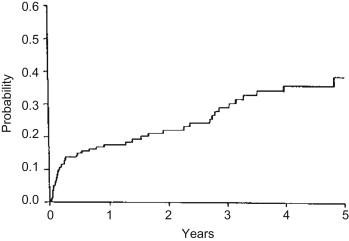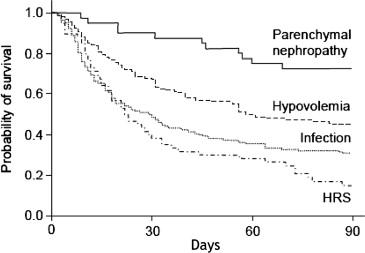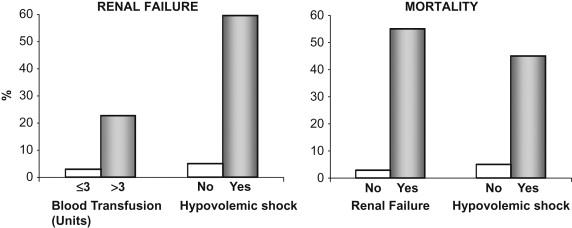Physical Address
304 North Cardinal St.
Dorchester Center, MA 02124
Renal failure is a common complication of patients with advanced cirrhosis. The most common causes of renal failure in cirrhosis are those related to bacterial infections (with or without septic shock) and hepatorenal syndrome. Other causes include renal failure due to the administration of non steroidal anti-inflammatory drugs (NSAIDs), that associated with gastrointestinal bleeding (with or without hypovolemic shock) and due to intrinsic renal disease. Because the approach to management of renal failure in patients with cirrhosis is different according to the etiology of renal failure, it is essential to establish the cause of renal failure before starting any specific therapy. Hepatorenal syndrome (HRS) is a potentially reversible cause of renal failure characterized by impaired renal function, marked alterations in cardiovascular function and over-activity of the sympathetic nervous and renin-angiotensin systems that lead to severe renal vasoconstriction and decreased glomerular filtration rate.
Patients with HRS for the most part exhibit clinical features of advanced cirrhosis and most have a high Model for End-Stage Liver Disease (MELD) and Child-Pugh scores along with low arterial blood pressure, low serum sodium and severe urinary sodium retention. Serum creatinine levels are elevated and define HRS; however they are usually lower than those seen in non-cirrhotic patients with acute renal failure due to a reduced muscle mass and low endogenous production of creatinine in cirrhosis. There are two types of HRS previously defined by the International Ascites Club. In Type 1 HRS renal function deteriorates rapidly with an increase in serum creatinine to a level higher than 2.5 mg/dl in less than two weeks. This type of HRS, if not treated, is associated with a very poor prognosis with a median survival time of two weeks. In Type 2 HRS there is a steady impairment of renal function and serum creatinine levels usually range between 1.5-2.5 mg/dl. Most patients with Type 2 HRS have a median survival time of 6-12 months if not transplanted. Type 1 HRS may develop spontaneously, but in many cases it is precipitated by bacterial infections such as spontaneous bacterial peritonitis (SBP) or sepsis, and acute alcoholic hepatitis.
The most important aspect of managing patients with HRS is considering their candidacy for liver transplantation as it is the treatment of choice for individuals with HRS, but it is not always applicable due to the short survival expectancy of listed candidates. Pharmacological therapies based on the use of vasoconstrictor drugs are the standard first line of therapy. The most widely used vasoconstrictor is intravenous terlipressin (a vasopressin analogue) along with albumin. This combination is associated with marked response rate of approximately 50%. Other treatments such as transjugular intrahepatic portosystemic shunts and renal replacement may be effective but experience is limited. Prevention of HRS can be attained with the use of albumin infusion in patients with SBP, with norfloxacin in patients very advanced liver disease and with -N-acetylcysteine in those with severe acute alcoholic hepatitis.
Key Words
cirrhosis, renal failure, hepatorenal syndrome, ascites, liver transplantation.
Renal failure is a common complication of patients with advanced cirrhosis. Early studies in patients with cirrhosis focused the attention on a distinctive form of renal failure characterized by progressive azotemia associated with marked abnormalities of the systemic arterial circulation and normal renal histology, a condition later known as hepatorenal syndrome (HRS). However, HRS is not the only cause of renal failure in cirrhosis. Patients with cirrhosis may develop renal failure due to a variety of clinical conditions, including bacterial infections (with or without septic shock), gastrointestinal bleeding (with or without hypovolemic shock), administration of non steroidal antiinflammatory drugs (NSAIDs), and intrinsic renal diseases, particularly glomerulonephritis associated with hepatitis B or C infection or alcoholic liver disease. Because the approach to management of renal failure in patients with cirrhosis is different according to the etiology of renal failure, it is essential to establish the cause of renal failure before starting any specific therapy. The aim of this chapter is to review the current approach to renal failure in patients with cirrhosis, with particular emphasis on the pathogenesis, diagnosis, and management.
The diagnosis of renal failure in patients with cirrhosis is established when serum creatinine increases over 1.5 mg/dL (133 µmol/L) which corresponds to a glomerular filtration rate (GFR) of approximately 30 ml/min. Although serum creatinine is the most commonly used GFR marker in cirrhosis, it has some limitations Serum creatinine may overestimate GFR mainly due either to decreased creatinine production or reduced muscle mass. Additionally, it is considered that baseline serum creatinine below <1.5 mg/dl does not necessarily exclude renal dysfunction. Creatinine clearance also overestimates GFR; more so in those with low GFR. There are no data to indicate that creatinine clearance is better or preferred to serum creatinine concentration as a marker of GFR in patients with cirrhosis. In addition, creatinine clearance is difficult to perform because it depends on the adequate collection of urine volume over 24 hours, which in many cases is inadequate, especially in oliguric patients. The estimation of GFR with the Cockcroft and Modification of Diet in Renal Disease (MDRD) equations are based on serum creatinine and therefore have not shown to be very useful in cirrhosis The gold standard for measuring GFR in cirrhosis relies on clearance techniques of exogenous markers. Use of these techniques allows the precise estimation of GFR, which helps to classify patients with chronic kidney disease according to categories previously defined by the National Kidney Foundation. Inulin has been the most widely used marker as it is completely filtered by the glomerulus without being secreted, reabsorbed, synthesized, or metabolized by the ducts. Thus, after an intravenous infusion and at a stable concentration in healthy subjects, the amount filtered equals to the amount excreted in urine. However, this method is cumbersome, expensive and not available in all settings. Other markers such as radiolabeled compounds (51Cr-EDTA, 99mTc-DPTA and 125I-iothalamate) or iohexol/iothalamate are useful, but there are expensive, they expose the patient to radiation if used repeatedly, and they have not been specifically or adequately studied in cirrhosis.
The above-mentioned limitation of using serum creatinine as a marker of renal function may require that the current definition undergo reassessment. New proposed criteria including the acute kidney injury and chronic kidney disease definitions may be useful in patients with cirrhosis but these need to be properly studied Given the above, serum creatinine concentration is still considered the method of choice to estimate GFR in cirrhosis in clinical practice. Although a single measurement of serum creatinine alone is probably inadequate for identifying and/or quantifying either acute or chronic renal disease in cirrhosis repeated measurements over time may be useful in indicating variations of GFR in clinical practice.
There are several causes of renal failure in cirrhosis due to a variety of clinical conditions ( Table 79.1 ). These etiologies are classified as: (1) renal failure associated with infections, (2) hypovolemia induced renal failure (3) intrinsic renal diseases, (4) hepatorenal syndrome (HRS), and (5) drug-induced renal failure. In patients with cirrhosis and ascites the one year probability of developing HRS ranges between 18-23% at one year and increases up to 40-50 % at three to five years of follow-up. ( Figure 79.1 ). A systematic review of 74 studies showed that the overall median mortality in patients with cirrhosis and renal failure was 67%, with a 58% mortality at 30 days and 63% mortality at one year In an analysis of 562 hospitalized patients with cirrhosis and renal failure, the most frequent cause of renal failure in cirrhosis was that associated with bacterial infections (46%), followed by hypovolemia-induced renal failure (32%), HRS (13%), parenchymal nephropathy (9%), drug-induced renal failure (7.5%), mixed causes (8%) and other causes (2%). Patients with intrinsic renal disease had a 73% survival at three months followed by a 46% survival in those with hypovolemia-related renal failure. Those with renal failure associated with infections and HRS had the lowest three-month survival probability, 31 and 15% respectively. ( Figure 79.2 ).
|


It is essential to establish the underlying etiology of renal failure before considering further management. That said, there are no specific tests that secure the diagnosis of the different types of renal failure in cirrhosis. In most cases a detailed clinical history, physical exam and assessment of renal function with a thorough evaluation of urine and serum electrolytes will suffice for establishing the cause ( Table 79.2 ). Renal ultrasonography needs to be performed in order to rule out the existence of abnormalities in renal structure suggestive of chronic kidney disease or urinary tract obstruction. Data on urine biomarkers and renal biopsy in the assessment of renal failure in cirrhosis is limited and therefore cannot be routinely recommended in the workup of renal failure in cirrhosis. Since the diagnosis of HRS cannot be made with a specific test, its confirmation is currently made using criteria to exclude other causes of renal failure that can occur in cirrhosis. So, if after an extensive investigation there is no evidence of infection, hypovolemia, administration of nephrotoxic drugs, or intrinsic renal diseases, then HRS should be considered the cause of renal failure. The diagnosis of HRS is based on specific clinical criteria that aim to exclude other causes of renal failure that are not functional, see ( Table 79.3 ) below.
| COMPLETE HISTORY |
| Infections/ sepsis |
| NSAID use, high doses of diuretics or other nephrotoxic drugs |
| Gastrointestinal bleeding |
| Long-term diabetes, hypertension |
| Urinary tract obstruction |
| PHYSICAL EXAMINATION |
| Volume status |
| Hemodynamics |
| Signs of infection or gastrointestinal bleeding |
| LABORATORY DATA |
| Serum creatinine, electrolytes, liver tests |
| Routine urine analysis, urine electrolytes, sediment |
| 24 hr urine volume, sodium, protein, creatinine |
| Culture—ascites, blood, urine |
| Renal ultrasound/Doppler |
|
* From: Salerno et al. Diagnosis, prevention and treatment of the hepatorenal syndrome in cirrhosis. A consensus workshop of the international ascites club. Gut 2007;56:1310-8.
Bacterial infections are the most common cause of renal failure in cirrhosis. The pathogenesis seems to be related to an impairment of the systemic arterial vasodilation present in cirrhosis due to bacterial products, cytokines or vasoactive mediators that appear in relation with the infection. This occurs mainly in patients that develop spontaneous bacterial peritonitis (SBP) and spontaneous bacteremia, but may occur with any bacterial infection It is estimated that bacterial infections are present at admission or during hospitalization in 20-60% of patients. Of these, most are secondary to SBP, other common causes are urinary tract infection, pneumonia and bacteremia which are due to both gram negative bacteria and aerobic gram-positive bacteria. Bacterial infections significantly increase mortality in patients with cirrhosis. A meta-analysis of 178 studies estimated that the overall mortality of infected patients with cirrhosis was 38%. The same analysis concluded that the mortality in those with SBP was 43.7% and in those with bacteraemia (1437 patients), the mortality was 42.2%. In any patient with cirrhosis that develops renal failure, the presence of a bacterial infection should be thoroughly sought after. It is important to take into account that signs and symptoms of early bacterial infection may be vague or even absent in some patients with cirrhosis. The mandatory workup consists of a complete blood cell count, liver chemistries, polymorphonuclear cell count in a sample of ascitic fluid, ascitic fluid cultures, urine sediment and culture, abdominal ultrasound, chest X-ray and blood cultures.
Pre-renal renal failure occurs due to a reduction in intravascular volume that causes a drop in renal plasma flow and GFR. In hypovolemia-induced renal failure the major mechanism responsible for renal hypoperfusion is a reduction in intravascular volume which, if severe, may lead to acute tubular necrosis (ATN). The main causes of hypovolemia in cirrhosis are gastrointestinal bleeding and overdiuresis due to excessive diuretic treatment followed by gastrointestinal fluid losses due to vomiting and/or diarrhea. In most cases, renal function improves after elimination of the precipitating cause and plasma volume expansion. Patients need to be thoroughly questioned about gastrointestinal bleeding, and physical examination should include a rectal exam to rule-out melena, bright red blood per rectum or occult blood if gastrointestinal bleeding is suspected. A naso-gastric tube should be considered if there is a high suspicion of upper GI bleeding. Additionally, if patients were taking diuretics, the type and doses need to be clarified. Patients with cirrhosis and gastrointestinal bleeding require an important reduction in blood volume which in most cases is associated with hypovolemic shock in order to develop renal failure. In moderate to severe cases of GI bleeding (those requiring >3 units of packed red blood cells) there is a 20% chance of developing renal failure. In mild cases this figure drops to less than 5%. When hypovolemic shock develops in patients with cirrhosis and gastrointestinal bleeding there is a 60% probability of developing renal failure and mortality rates are very high ( Figure 79.3 ).

Become a Clinical Tree membership for Full access and enjoy Unlimited articles
If you are a member. Log in here